Metal silos and super grain bags improve grain storage in Zimbabwe and Zambia
Farmers in Zimbabwe and Zambia, who have been losing their maize harvests due to poor storage facilities, can now effectively store their grain in metal silos and super bags, courtesy of Effective Grain Storage for Sustainable Livelihoods of African Farmers (EGSP) Phase- II Project. The five-year project funded by the Swiss Agency for Development and Cooperation (SDC) was launched in Zimbabwe and Zambia on 17 and 20 September 2012, respectively. It aims to improve food security and reduce vulnerability of resource-poor farmers, particularly women farmers, in eastern and southern Africa through the dissemination of metal silos and super grain bags. According to project leader Tadele Tefera, annual post-harvest grain losses in the sub-Saharan region are currently estimated at US$ 4 billion. “This is equivalent to a decade of food aid for the region, or enough annual calories for about 48 million people,” he noted.
The project allows CIMMYT scientists, partners, and collaborators in Zimbabwe and Zambia to exchange ideas, information, and research outputs; raise awareness on promotion and dissemination of effective grain storage technologies; and consult stakeholders on policy environment and market issues for effective implementation of EGSPII. Presiding over the launch in Harare, Danisile Hikwa (principal director of the Department of Research and Specialist Services, Ministry of Agriculture, Zimbabwe) warned of the negative impact of post-harvest losses on food security: “The potential impact of increased maize productivity on poverty reduction and greater livelihood security will not be realized unless technological and institutional innovations are identified and deployed to overcome the chronic syndrome of ‘sell low’ and ‘buy high’. The existing best-bet post-harvest technologies need to be rapidly scaled-up and disseminated in the region.”
Wilfred Mwangi, CIMMYT regional liaison officer, noted that the traditional granaries have failed to protect farmers’ maize harvests against the two most destructive post-harvest insect pests in the region, maize weevils and larger grain borers. “As a result of lack of adequate awareness and access to appropriate technologies, farmers end up selling their maize soon after harvest, when prices are at their lowest, partly to curb the losses and partly to meet other financial needs. The same farmers are forced to buy the grains back at more than twice the price later in the season to meet their subsistence needs, resulting in a continual poverty trap,” said Mwangi.
In her opening address in Harare, Nadia Otigger, SDC quality assurance adviser for South Africa, reiterated her government’s commitment to reduce poverty in southern Africa, as Switzerland just approved a new strategy with focus on agriculture and food security, aiming to contribute to poverty reduction through the promotion of economically, ecologically, and socially sustainable agricultural production, especially for smallholder farmers. Launching the project in Lusaka, Honorable Rodgers Mwewa, Deputy Minister for Agriculture and Livestock, Zambia, noted that self-sufficiency in food grains in the country does not depend only on increased production but also on minimizing post-harvest losses. “It is economical and environmentally appropriate to protect the harvested maize rather than to continue opening up new land and increase application of chemical fertilizers in the name of increasing production,” he added.
Juliane Ineichen, SDC deputy director for Southern Africa, spoke during the launch in Lilongwe and noted that Switzerland expects to see changes in the lives of smallholder farmers with specific needs and requirements who are facing all kinds of challenges while producing crops and providing food; as well as in institutions and policies providing enabling conditions for smallholder farmers to improve their situations.
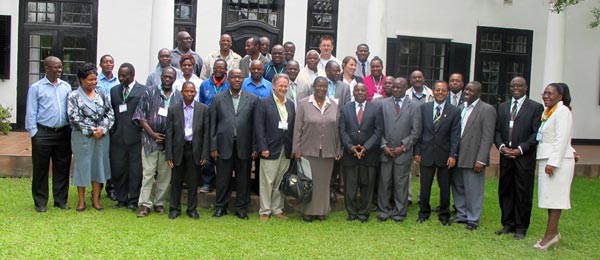
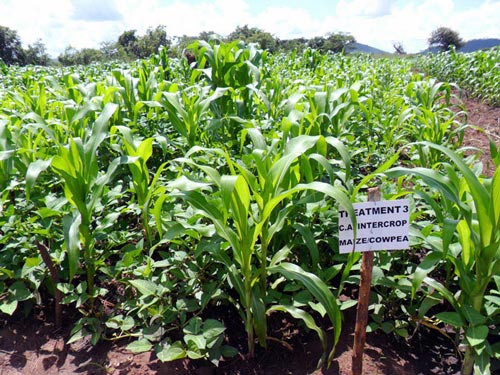 To reduce farm labor, improve soil productivity and crop yields, and contribute towards food security of farming households in the changing climate environment, CIMMYT, the
To reduce farm labor, improve soil productivity and crop yields, and contribute towards food security of farming households in the changing climate environment, CIMMYT, the 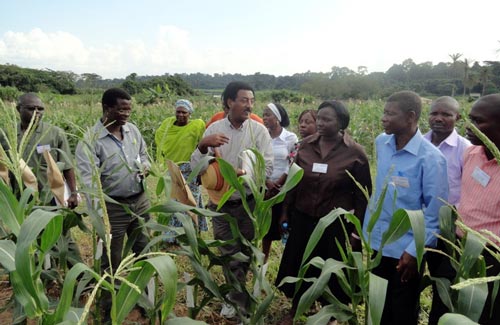 Having experienced CA, both Tembo and Zulu hope that more farmers will adopt the practice. “This project should continue so that others can learn from us that we do things differently now,” she added. Learning about CA has enabled Tembo to lessen the challenges her family faces, especially the tedious labor in preparing the field. Zulu is proud to see that other farmers admire what they see on his farm.
Having experienced CA, both Tembo and Zulu hope that more farmers will adopt the practice. “This project should continue so that others can learn from us that we do things differently now,” she added. Learning about CA has enabled Tembo to lessen the challenges her family faces, especially the tedious labor in preparing the field. Zulu is proud to see that other farmers admire what they see on his farm. Maize plays a pivotal role in the livelihoods of people in southern Africa: its annual per capita consumption is around 85 kg. In the past season, however, farmers in Angola, Botswana, Lesotho, Swaziland, and much of Zimbabwe experienced a severe drought that significantly reduced their harvests.
Maize plays a pivotal role in the livelihoods of people in southern Africa: its annual per capita consumption is around 85 kg. In the past season, however, farmers in Angola, Botswana, Lesotho, Swaziland, and much of Zimbabwe experienced a severe drought that significantly reduced their harvests.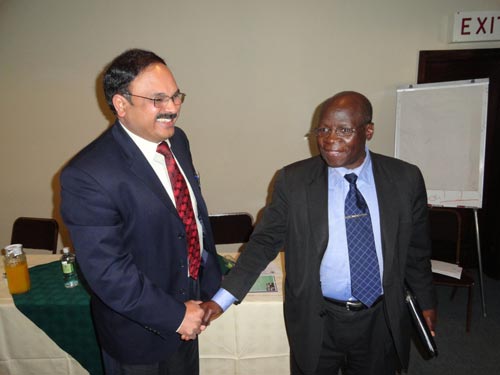 Participants discussed some of their notable achievements from 2011-12. Angola began its first commercial-scale production of the drought tolerant hybrid seed with Agropequária Kambondo and produced significant quantities of the drought tolerant openpollinated variety (OPV) ZM523. Farmers in the Democratic Republic of the Congo produced 80 tons of the drought tolerant OPV ZM623 through community-based seed schemes. Lesotho released a quality protein maize variety, and Zambia’s national program made significant progress in breeding for drought tolerance. Local emerging seed companies in Mozambique have begun production of one drought tolerant OPV and three drought tolerant hybrids.
Participants discussed some of their notable achievements from 2011-12. Angola began its first commercial-scale production of the drought tolerant hybrid seed with Agropequária Kambondo and produced significant quantities of the drought tolerant openpollinated variety (OPV) ZM523. Farmers in the Democratic Republic of the Congo produced 80 tons of the drought tolerant OPV ZM623 through community-based seed schemes. Lesotho released a quality protein maize variety, and Zambia’s national program made significant progress in breeding for drought tolerance. Local emerging seed companies in Mozambique have begun production of one drought tolerant OPV and three drought tolerant hybrids.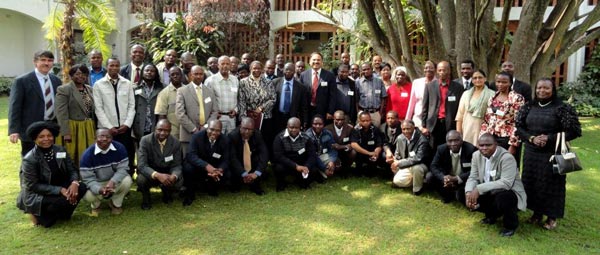
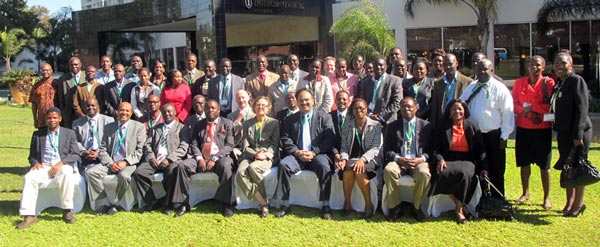
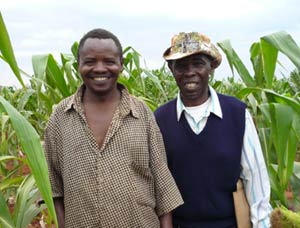 In the 2006-07 cropping season, 82 registered maize seed companies produced the bulk of just over 100,000 tons of improved maize seed that were marketed in the major maize producing countries of eastern and southern Africa (excluding South Africa) — enough to sow 35% of the maize land in those countries.
In the 2006-07 cropping season, 82 registered maize seed companies produced the bulk of just over 100,000 tons of improved maize seed that were marketed in the major maize producing countries of eastern and southern Africa (excluding South Africa) — enough to sow 35% of the maize land in those countries.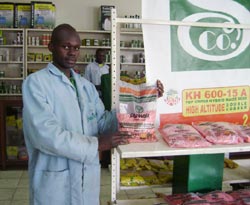
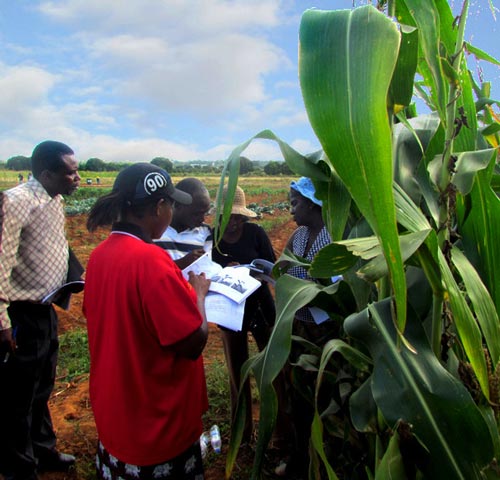 During the week of 15-20 April 2012, 36 maize technicians participated in a training session in Lusaka, Zambia. The participants were selected from seven seed companies in Zambia, national agricultural research organizations, and NGOs involved in agricultural research and extension in the eastern province of Zambia. The objective of the course was to update maize technical staff on implementing on-station and on-farm trials, seed production, and the use of secondary traits in selecting superior genotypes under low nitrogen, heat and drought trials, and it combined both lectures and field work.
During the week of 15-20 April 2012, 36 maize technicians participated in a training session in Lusaka, Zambia. The participants were selected from seven seed companies in Zambia, national agricultural research organizations, and NGOs involved in agricultural research and extension in the eastern province of Zambia. The objective of the course was to update maize technical staff on implementing on-station and on-farm trials, seed production, and the use of secondary traits in selecting superior genotypes under low nitrogen, heat and drought trials, and it combined both lectures and field work.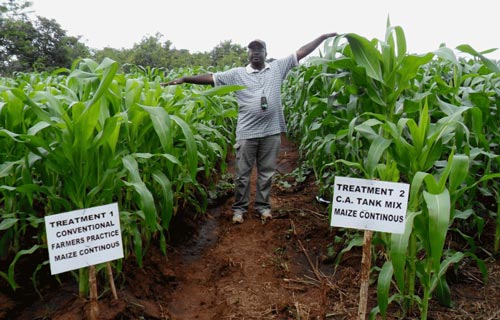 During 06-10 February 2012, a team of CIMMYT scientists travelled to six communities in Zambia’s Eastern Province to monitor progress on activities implemented under the Sustainable Intensification of Maize-Legume systems for the Eastern Province of Zambia (SIMLEZA) project, funded by USAID as part of Barack Obama’s “Feed the Future” initiative. The team was joined by national partners from governmental extension services, field coordinators from Total Land Care, Zambian researchers from Msekera Research Station, IITA, and CIP, and a group of farmers from Monze, in Zambia’s Southern Province. Journalists from two radio stations, one daily newspaper, and Zambian television covered the visit.
During 06-10 February 2012, a team of CIMMYT scientists travelled to six communities in Zambia’s Eastern Province to monitor progress on activities implemented under the Sustainable Intensification of Maize-Legume systems for the Eastern Province of Zambia (SIMLEZA) project, funded by USAID as part of Barack Obama’s “Feed the Future” initiative. The team was joined by national partners from governmental extension services, field coordinators from Total Land Care, Zambian researchers from Msekera Research Station, IITA, and CIP, and a group of farmers from Monze, in Zambia’s Southern Province. Journalists from two radio stations, one daily newspaper, and Zambian television covered the visit.